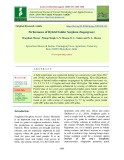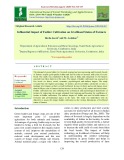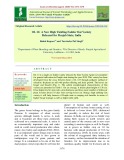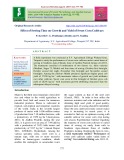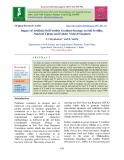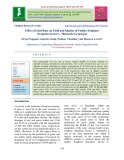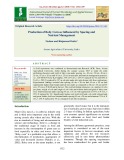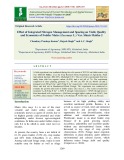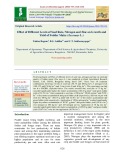
Green fodder yield
-
Field experiment was conducted at research farm Bihar agricultural university, Sabour during Kharif -2019 to find the appropriate row ratio of cereal and legume intercrop for better quality of forage with maximum net returns. Intercropping system had significant effect on nutritive value of forage crops and economics.
 10p
10p  chauchaungayxua11
chauchaungayxua11
 23-03-2021
23-03-2021
 14
14
 2
2
 Download
Download
-
The Treatments consists of 2 levels of Potassium viz. K1(40 kg K2O/ha), K1(50 kg K2O/ha) and 4 levels of Iron viz.10 and 20 kg/ha as basal and 0.1 and 0.2% as foliar application. There were 9 treatments each being replicated thrice and laid out in Randomized Block Design. The results revealed that treatment T8 (50kgs potassium + 0.2% iron) recorded maximum Dry weight, Number of cobs per plant, cob length, cob girth , cob weight without husk, cob yield without husk, Green fodder and B: C ratio.
 6p
6p  chauchaungayxua11
chauchaungayxua11
 23-03-2021
23-03-2021
 10
10
 2
2
 Download
Download
-
Fodder crops play a vital role in agriculture since continuous supply of nutritious green fodder in sufficient quantity is basic requirement for livestock to cater milk production and also to maintain the health of the livestock. The availability of good quality green fodder is far less than the requirement in Ramanagara district of Karnataka state.
 6p
6p  cothumenhmong9
cothumenhmong9
 18-01-2021
18-01-2021
 9
9
 2
2
 Download
Download
-
An experiment was conducted to exploit heterosis in F1 hybrids of sweet sorghum (Sorghum bicolor L.) and to identify parents with desirable genetic effects with respect to single-cut green fodder yield and its component traits. 48 F1 hybrids were evaluated to assess general and specific combining ability and gene action governing the green fodder yield and its attributing traits.
 9p
9p  cothumenhmong9
cothumenhmong9
 04-01-2021
04-01-2021
 14
14
 2
2
 Download
Download
-
Subabul is an important protein rich tree fodder which its lopping is extensively used as cattle fodder. It is drought resistant tree, generally grown as border or bund crop in farmers and its lopping is cut for green fodder for animals. For this purpose tree fodder cultivating seems to be a promising strategy for livestock farmers. A field experiment was conducted to find out the relative performance of tree fodder growth at various stages of cutting and suitable lopping interval of subabul (Leucaena leucocephala) during 2019-2020.
 4p
4p  trinhthamhodang9
trinhthamhodang9
 16-12-2020
16-12-2020
 11
11
 1
1
 Download
Download
-
Green fodder supplementation is the best way to reduce the cost of production in livestock farming. The expenditure on concentrate feed will be curtail by feeding of legume fodder. Urbanization reduces the land area for fodder production and also the failure in monsoon urges the farmers to go for fodder production under agroforestry models. Calopogonium mucunoides is a fodder legume with high quality protein and grows fast and remain productive during dry seasons.
 4p
4p  nguathienthan8
nguathienthan8
 20-10-2020
20-10-2020
 20
20
 2
2
 Download
Download
-
Cotton (Gossypium hirsutum L.) is the most important cash crop and there is a demand for simultaneous increase in the productivity of cotton, edible oilseeds and fodders to fulfil the diversified needs of growing population. For this purpose, cotton-based intercropping seems to be a promising strategy. Short duration legume fodders are potential sources of nutrients during summer especially atmospheric nitrogen fixing which are supplement of inorganic fertilizers.
 6p
6p  nguaconbaynhay8
nguaconbaynhay8
 13-10-2020
13-10-2020
 17
17
 1
1
 Download
Download
-
Keeping above facts in view the present investigation was planned to sort out better dual purpose barley varieties for filling the wider gap between demand and supply of green forage in the country and for taking grain yield from the regenerated crop.
 6p
6p  chauchaungayxua8
chauchaungayxua8
 03-10-2020
03-10-2020
 7
7
 1
1
 Download
Download
-
A field experiment was conducted during two consecutive years from 2014 and 2015 at Agricultural Research Station, Kota, Significantly higher green fodder yield (907 q/ha) and dry fodder yield (245 q/ha) were observed with sowing of Sugargraze by 9.5 kg seed/ha over local chari sowing by 10.0 kg seed/ha green fodder yield (668 q/ha) and dry fodder yield (168 q/ha). However, it was found at par with sowing of Sugargraze by 7.5 kg seed/ha green fodder yield (896 q/ha) and dry fodder yield (242 q/ha).
 5p
5p  cothumenhmong7
cothumenhmong7
 09-09-2020
09-09-2020
 12
12
 2
2
 Download
Download
-
In the India, three to four cutting are possible, typical yield distribution is 30-35 percent in the first cutting, 35-40 percent in the second cutting and 20-25 percent in subsequent cutting. More consistently high quality forage is obtained by grazing, green chopping and ensiling early spring growth to stimulate recovery growth, fertilize with nitrogen immediately following the initial cutting (Smith et al., 2005).
 6p
6p  cothumenhmong7
cothumenhmong7
 09-09-2020
09-09-2020
 12
12
 1
1
 Download
Download
-
The present investigation was under taken for 10 lines and 3 tester using line x tester mating design consisted of 46 entries including 10 lines, 3 testers, 30 hybrids and three checks viz., CSV 23, CSV 27 and CSH25. These were evaluated in RBD with three replications during kharif 2015 in four environments created by using different spacing viz., 22.5 x 5 cm (E1), 30 x 10 cm (E2), 45 x 10 cm (E3) and 60 x 10 cm (E4) at Instructional farm Rajasthan college of Agriculture, Udaipur in randomized block design with three replications.
 25p
25p  cothumenhmong7
cothumenhmong7
 08-09-2020
08-09-2020
 18
18
 1
1
 Download
Download
-
A field experiment was conducted during two consecutive years from 2017 and 2018at Agricultural Research Station Ummedganj, Kota (Rajasthan), sowing of hybrid fodder sorghum (sugargraze) by different seed rates viz. 3.5, 5.5,7.5, 9.5, 11.5 kg/ha and local chari 10.0 kg/ha. The fodder yield of sugargraze was significantly influenced by sowing of different seed rate. Pooled data of two years gave significantly higher green fodder yield(898 q/ha) and dry fodder yield (241 q/ha) were observed by sowing of sugargraze 9.5 kg seed/ha over local chari sowing by 10.
 6p
6p  caygaocaolon6
caygaocaolon6
 30-07-2020
30-07-2020
 12
12
 2
2
 Download
Download
-
The demand of green fodder for livestock rearing has been increasing and livestock breeds of farmers require good quality fodder and feed in order to increase milk yield of exotic breed. The study was conducted in Kerala state of India and comprised of 242 farmers selected from three districts of the state. The impact of fodder cultivation was assessed on five levels viz. direct, social, economic, psychological and indirect impact. The study revealed that the highest percentage of farmers perceived fodder cultivation to have a medium level impact on their overall livelihood.
 9p
9p  angicungduoc6
angicungduoc6
 22-07-2020
22-07-2020
 12
12
 1
1
 Download
Download
-
OL 12 is a single cut fodder variety released by State Variety Approval committee for general cultivation in Punjab state during the year 2018. This variety has been developed from the cross between Kent x OL 125 through pedigree method of selection. Its plants are tall with profuse tillering and leafy growth. The leaves are longer and broader (Fig. 1). The salient morphological characteristics of this variety are presented in Table 1. On an average, it attains plant height of 138 cm. It has higher leaf to stem ratio, stem thickness and bears more number of tillers per plant.
 5p
5p  angicungduoc6
angicungduoc6
 22-07-2020
22-07-2020
 10
10
 2
2
 Download
Download
-
A field experiment was conducted at S.V. Agricultural College Wetland farm, Tirupati to study the performance of sweet corn cultivars under varied times of sowing in Southern Agro-Climatic Zone of Andhra Pradesh during rabi 2011. The treatments consisted of combination of two factors viz., three varieties (Madhuri, Sugar 75, Misthi) and four times of sowing (October first fortnight, October second fort night, November first fortnight and November second fortnight).
 6p
6p  kethamoi6
kethamoi6
 29-06-2020
29-06-2020
 18
18
 3
3
 Download
Download
-
To study the impact of artificial creation of soil fertility gradient strategy on soil fertility, nutrient uptake and green fodder yield of sorghum (var. CO 30) by following inductive methodology (fertility gradient concept), a field experiment was conducted during 2014-15 at farmer’s holding of Coimbatore district. The experimental field was divided into three equal strips and three graded levels of fertiliser N, P2O5 and K2O were applied in the form of urea, single super phosphate and muriate of potash, respectively to strip I (N0P0K0), II (N1P1K1) and III (N2P2K2).
 7p
7p  chauchaungayxua6
chauchaungayxua6
 26-06-2020
26-06-2020
 19
19
 3
3
 Download
Download
-
The experimental soil was clay in texture, slightly alkaline in reaction, medium in available nitrogen, phosphorus and potassium. The results revealed that seed rate of 45kg/ha recorded maximum dry matter accumulation at 40 DAS and at harvest. The percent increase in green and dry fodder yield of this seed rate over seed rate of 30 and 35 kg/ha were 14.21, 21.91 and 7.41, 11.02 respectively. Seed rate of 45kg/ha recorded significantly higher N and P uptake over 40, 35 and 30 seed rate/ha but N and P content did not influence significantly by increased seed rate.
 17p
17p  nguaconbaynhay6
nguaconbaynhay6
 24-06-2020
24-06-2020
 12
12
 1
1
 Download
Download
-
A field experiment was conducted at Instructional-cum-Research (ICR) Farm, Assam Agricultural University, Jorhat during the summer season, 2017 to study the yield attributing characters and yield of baby corn under spacing viz., 40 cm x 20 cm, 40 cm x 25 cm, 45 cm x 20 cm and 45 cm x 25 cm in main plot and nutrient management practices viz., 120-60-60 N-P2O5-K2O (kg/ha), 75% of N of I1 + 25% N replaced by VC and 50% of N of I1 + 50% N replaced by VC in sub plot under split-plot design with three replications.
 8p
8p  quenchua6
quenchua6
 15-06-2020
15-06-2020
 10
10
 2
2
 Download
Download
-
A field experiment was conducted during the rabi season of 2017-18 on fodder maize crop (var. SHIATS Makka- 2) at the Crop Research Farm, Department of Agronomy, Naini Agricultural Institute, SHUATS, Allahabad (U.P.).
 5p
5p  nguathienthan5
nguathienthan5
 04-06-2020
04-06-2020
 14
14
 1
1
 Download
Download
-
Field experiment on Effect of different levels of seed rate, nitrogen and zinc on yield and quality of fodder maize (Zea mays L.) was conducted at Zonal Agricultural Research Station, UAS, GKVK, Bengaluru during kharif 2017. There were 18 treatment combinations involving 3 levels of seed rate (50, 75 and 100 kg ha-1 ), 3 nitrogen levels (100, 125 and 150 kg ha-1 ) and 2 zinc levels (0 and 10 kg ha-1 ). The experiment was laid out in a FRCBD, replicated thrice.
 9p
9p  trinhthamhodang1213
trinhthamhodang1213
 30-05-2020
30-05-2020
 17
17
 1
1
 Download
Download
CHỦ ĐỀ BẠN MUỐN TÌM









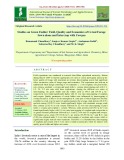
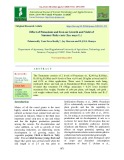
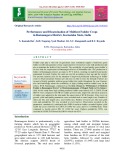
![Heterosis and combining ability studies in sweet sorghum [Sorghum bicolor (L.) Moench] for green fodder yield and its contributing traits Heterosis and combining ability studies in sweet sorghum [Sorghum bicolor (L.) Moench] for green fodder yield and its contributing traits](https://tailieu.vn/image/document/thumbnail/2021/20210104/cothumenhmong9/135x160/4401609772049.jpg)
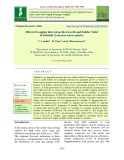
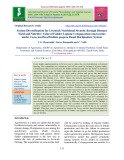
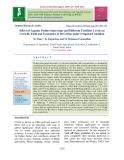
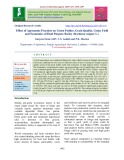
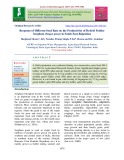
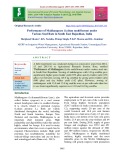
![Estimation of heterosis, heterobeltiosis and economic heterosis in dual purpose sorghum [Sorghum bicolor (L.) Moench] Estimation of heterosis, heterobeltiosis and economic heterosis in dual purpose sorghum [Sorghum bicolor (L.) Moench]](https://tailieu.vn/image/document/thumbnail/2020/20200908/cothumenhmong7/135x160/7011599548523.jpg)
